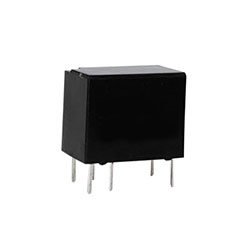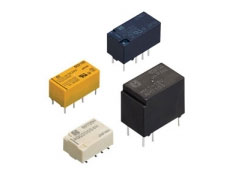What are the Types of Signal Relays?
Signal relays are commonly used devices in automatic control systems, usually used to connect and disconnect circuits to issue control commands and reflect equipment status. They are important components that constitute automatic control and remote control circuits. Signal relays can be classified according to the nature of the relay's operating current, operating principle, physical properties, operating speed, contact structure, and reliability of operation.
Based on the Nature of Relay Action Current
Signal relays can be divided into DC relays and AC relays based on the nature of the relay's operating current.
- DC relay
 : DC relays are powered by a DC power source, and can be divided into pole less relays, pole biased relays, and polarity holding relays according to the polarity of the current.
: DC relays are powered by a DC power source, and can be divided into pole less relays, pole biased relays, and polarity holding relays according to the polarity of the current. - AC relay: AC relays are powered by AC power supply. According to the operating principle, AC relays can be divided into AC electromagnetic relays and AC induction relays.
Based on the Operating Principle of Relays
According to the operating principle of relays, signal relays can be divided into electromagnetic relays, induction relays, thermal relays, etc.
- Electromagnetic relay: The principle of electromagnetic relay is to generate magnetic flux through the current in the relay coil, forming electromagnetic force, attracting the armature and driving the contact action. This type of relay has the highest number.
- Induction relay: Induction relays use the alternating magnetic field generated by the current passing through the coil to interact with the current induced by another alternating magnetic field in the wing plate to generate electromagnetic force, causing the wing plate to rotate and act.
- Thermal relay: Thermal relays utilize the physical characteristics of unidirectional bending generated by heating two metal plates with different expansion coefficients to activate the contacts.
Based on the Physical Properties of Relay Inputs
According to the physical properties of relay inputs, signal relays can be classified into current relays, voltage relays, power relays, frequency relays, etc.
- Current relay: Current relays reflect changes in current, and their coils must be used in series in the circuit.
- Voltage relay: A voltage relay reflects changes in voltage, and its coils must be used in parallel in the circuit. Its excitation circuit is composed separately.
- Power relay: Power relays reflect changes in power.
- Frequency relay: Frequency relays reflect changes in AC frequency. Some relays combine voltage relays and current relays. For example, the JWJXCH125/0.44 relay has two coils, where the front coil of 125 Ω is the voltage coil and the rear coil of 0.44 Ω is the current coil.
Based on the Pperating Speed of Relays
According to the operating speed of relays, signal relays can be divided into fast acting relays, normal acting relays, and slow acting relays.
- Quick acting relay: The action speed of the fast acting relay is very fast, and the general action time is less than 0.1 seconds.

- Normal acting relay: The normal action time of a relay is 0.1-0.3 seconds, and most signal relays belong to this category.
- Slow acting relay: When the action time of the relay armature exceeds 0.3 seconds, the relay is called a slow acting relay. Slow acting relays are also divided into slow suction type relays and slow release type relays.
Based on the Contact Structure of Relays
According to the contact structure classification of relays, signal relays can be divided into ordinary contact relays and reinforced contact relays.
- Ordinary contact relay: Ordinary contact relays have the ability to open and close loads with low power to meet the requirements of general signal circuits. Most relays are ordinary contact relays.
- Reinforced contact relay: Reinforced contact relay have the ability to open and break loads with high power to meet the requirements of signal circuits with high current.
Based on Reliability of Relays Operation
According to the reliability level of work, signal relays can be divided into safety relays and non-safety relays.
- Safety relay: A safety relay refers to a relay whose action must comply with the fault safety principle (after one or several faults occur in the system's equipment, the result is to output according to a predetermined state that ensures the safe operation of the system, which is called the fault safety principle). Most of the relays used in railway signaling systems are safety type relays.
- Non-safety relay: Non-safety relays mainly rely on the elastic force of the spring to release the armature, so they are also known as elastic relays. Generally speaking, the safety and reliability of non-safety relays are lower than those of safety relays.
Signal relays find applications in telecommunications, instrumentation, control systems, automotive electronics, audio equipment, and various other fields where the control and switching of low-power signals are required. The choice of a signal relay type depends on the specific requirements of the application, including voltage, current, switching speed, and reliability.Please feel free to contact ATO Store if you have any question about our products, we will reply you as quickly as we can!

